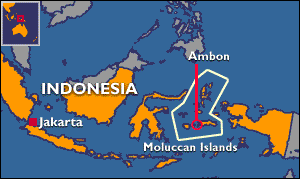

Its Origins
Discover where different spices originate and who used them
Where do spices come from and who used them?

Spices have been used since the beginning of human civilisation.
The first hunter/gather was known to wrap food in the leaves of spice plants as a preservative.
China
The most common spices found in Ancient China were:
Nutmeg
Cloves
Ginger
Cinnamon
Fennel
Turmeric
Lemongrass
While many believe that cinnamon was native to Egypt, the spice in fact originated from China.
Nutmeg and cloves were brought to China by way of the Moluccas, also known as the 'Spice Islands', which are a group of islands located in Indonesia.
Fun Fact
The indigenous people of the Spice Islands historically planted a new clove tree for every child born.

Map of the Moluccas, The Spice Islands
Courtiers in the third century B.C. were known to carry cloves to freshen their breath before speaking to emperors.
By the fifth century, ginger was widely used by the Chinese and even take on sea voyages for fresh food, as well as to prevent scurvy.
The Chinese five-spice powder traditionally contains: cinnamon, cloves, fennel, star anise, and peppercorns. Some recipes will also add other ingredients like ginger, nutmeg, and liquorice.
All spices originating from China.
Egypt
Spices were heavily used in Ancient Egyptian culture as a food preservative and medicinal purposes.
Written on Egyptian Papyri, there is evidence of Ancient Egyptians using spices since 1555AD.
Fennel
Cumin
Coriander
Garlic
and Thyme
were all used for health benefits or as an ailment to injuries.
Coriander was one of the most favoured spices/herbs in Ancient Egypt. It was thought of as an aphrodisiac and therefore often left in the tombs of lovers to represent undying love and affection.
Cinnamon was expensive and used in the embalming process whilst
Cumin was thought to help with stomach or digestion issues.
Why?
Egypt is located in the middle of the spice route of the time and therefore had easy access to an abundance of spices from The East as well as from Italy and Greece.
Middle East
The modern day Middle East, which includes Iraq, Kuwait, Saudi Arabia, Syria and Turkey were once known as the Tigris and Euphrates Valleys in Mesopotamia. Many aromatic spice plants were known to originate here.

These clay tablets are the first record that note the medical use of spice plants in the Middle East.
The spices listed include:
Cardamom
Thyme
Saffron
Turmeric
Cumin
Coriander
Dill
Garlic
Clay Tablets from Sumeria, Third Millennium. © The Metropolitan Art Museum
A famous example of the use of Middle Eastern spices is by King Merodach-baladan II (721-710 BC) of Babylonia who grew 64 different species of plants in his royal garden.
He kept records on how to cultivate many spices and herbs, such as cardamom, coriander, garlic, thyme, saffron, and turmeric.
In fact, the Babylonia mythology involved worshiping certain gods. Sumerian Nanna, the moon god controlled medicinal plants and were worshipped by those in Mesopotamia for good health.
India
Aromatic spices are most commonly associated with Indian cooking. These spices have been cultivated and commonly used for thousands of years beginning around the eighth century BC in Babylon.
A few Indian spices include:
Cumin
Cardamom
Coriander
Black pepper
Mustard
Cayenne pepper
Cinnamon
Horseradish
Nutmeg
Cloves
These spices all have a variety of properties, but were mostly used as preservatives, antiseptics, and disinfectants.
Fun Fact
White Mustard was sprinkled onto bed sheets to prevent evil spirits.
Ancient Rome
Romans were the most extravagant users of aromatics and spices in history. When the Romans conquered Egypt in 50BC spices were urgently desired by central Europe. Romans used spices within the household to both disguise the taste of food and to promote to guests the time and money spent on a meal by the host.
Some of the most common spices during the Roman period were pepper, thyme, bay leaf, basil, dill, ginger, cumin and saffron.
The most famous Roman recipe books were produced by Marcus Apicius. He published a collection of 450 recipes organised into 10 books:
The Careful Housekeeper, The Meat Mincer, The Gardener, Many Ingredients, Pulse, Birds, The Gourmet, The Quadruped, The Sea, and The Fisherman.

Drawing of Marcus Gavius Apicius who wrote a collection of recipe books in Ancient Rome

Apicius, The Careful Housekeeper, 1AD
The Careful Housekeeper dates from the first century and gives instruction on how to keep food fresh. The first recipe from the first chapter of the book is titled ‘Fine Spiced Wine’. Chapter seven also includes a recipe for how ‘To keep meat fresh without salt’. Both recipes use spices to improve the taste and preserve food.
From the beginning of human civilisation, spices have been used to add flavour and preserve food. Not much has changed in thousands of years. Continue the history of spices, with a look at the spice trade.



